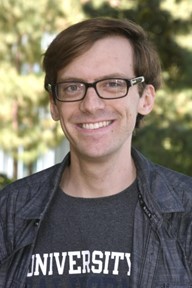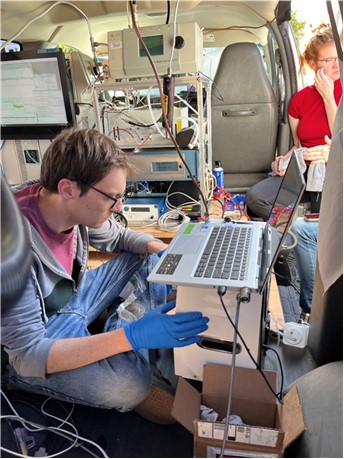The Next Wave – Adam Thomas
AirUCI grad student Adam Thomas is a whiz at multitasking. He has a hand in many of the projects underway in Jim Smith’s research group—from the groundbreaking Beyond the Tailpipe project to analyzing field data from the Amazon Rainforest, Adam handles everything from field studies to instrument development to authoring papers to laboratory experiments with ease. He works in collaboration with several other AirUCI research teams including the Finlayson-Pitts, Shiraiwa, Guenther, and Nizkorodov groups on projects that overlap with those in the Smith group. 
The focus of studies in the Smith group is ultrafine particles, defined as nanoparticles with diameters 100 nm or smaller. In the lab and in the field, they probe the formation and composition of these particles and collaborate with other AirUCI researchers to study the impacts of these on health and climate. The team studies nanoparticles in the lab by reacting various organic and inorganic gases under different environmental variables (temperature, relative humidity) and seeing how these variables affect nanoparticle growth and composition.
These projects utilize various types of equipment—many of which have been designed and built by the Smith team—including their Thermal Desorption Chemical Ionization Mass Spectrometer (TDCIMS), their Transverse Ionization Chemical Ionization Mass Spectrometer (TI-CIMS), and various modifications to commercial instruments. When AirUCI’s new Orbitrap mass spectrometer arrived in 2020, Adam was instrumental in establishing operation procedures and training new users, sharing the tricks of his experience.
The team conducts extensive field studies as well. Their work on AirUCI’s Beyond the Tailpipe project was critical to the success of this endeavor that included 13 AirUCI faculty and their teams. Emissions from non-tailpipe sources, such as from brake and tire wear, are known to contribute to particulate pollution, and studying these particles and gases was the basis of the entire project.
The Tailpiper team designed and built a brake and tire dynamometer to experimentally generate brake and tire wear gases and particles so they could probe their composition in a controlled laboratory environment. Adam played a fundamental role in the development and operation of this apparatus and was the lead author on a paper published in the Proceedings of the National Academy of Sciences reporting on the character-ization of charged particles emitted by brake wear. The team then put  together a mobile laboratory packed with instruments and drove it to various high-traffic locations in Santa Ana to obtain air samples and analyze them for the presence of particles and gases. Adam, shown here in the mobile lab with AirUCI postdoc Madeline Cooke, was a key organizer of these field studies and participated personally in each of them.
together a mobile laboratory packed with instruments and drove it to various high-traffic locations in Santa Ana to obtain air samples and analyze them for the presence of particles and gases. Adam, shown here in the mobile lab with AirUCI postdoc Madeline Cooke, was a key organizer of these field studies and participated personally in each of them.
In the Eastern Pacific Cloud Aerosol Precipitation Experiment (EPCAPE) which took place in 2023 in La Jolla, California, the Smith group deployed their tools to study how marine aerosol particles are formed and influenced by urban emissions. In Houston, Texas in 2022, Jim’s team was again in the field to study how urban particles form and grow. In both these studies, Adam mentored junior lab members on everything from which spare parts they should pack to checking and calibrating instruments to data analysis.
In addition to his wide range of duties in both lab and field studies, Adam has been a key participant in both AirUCI-sponsored student groups: UCI’s student chapter of the American Association for Aerosol Research (AAAR) and our own Internal Seminar. He has held various positions as an officer in the AAAR chapter and is active in organizing meetings for both groups.
After achieving his B.S. at the University of California, Riverside, Adan nearly became a Materials Science grad student. Instead he took a job as an analytical chemist in a flavor company where he discovered a passion for analytical chemistry and mass spectrometry. After that experience he decided to go to grad school, this time in chemistry. Adam is an excellent classroom teacher, assisting with courses taught by Jim Smith, and has worked with UCI Professor Steve Mang to deliver course content for his writing class, Chem 101W.
Adam clearly has excellent taste in music—he especially loves the Beatles. When he’s not in the lab, in the field, or organizing meetings, Adam likes to watch movies (all kinds), read classic fiction, and grab food with friends. He hopes to continue his career in either the government agency or academic sectors after obtaining his Ph.D. We look forward to Adam's continuing contributions to AirUCI research and what promises to be an exciting future for him in addressing environmental issues.

